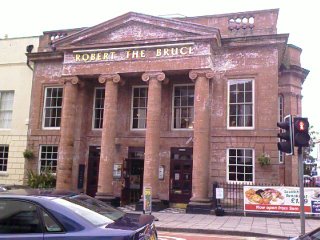 OK, time to turn on the Twilight Zone music. If you're not into believing in past life experiences or weird reactions to surroundings, stop reading now, or you might begin to question my sanity.
OK, time to turn on the Twilight Zone music. If you're not into believing in past life experiences or weird reactions to surroundings, stop reading now, or you might begin to question my sanity.This morning I planned to visit Sweetheart Abbey (yes, I admit it, purely for the romance of its story about its lady founder who is buried with her beloved's heart) and got a later start than planned because of my wandering feet and a sense of déjà vu that continues to tug at my sleeve everywhere I go today.
Coming into Scotland has tapped some deep visceral responses. On the train ride from Carlisle to Dumfries yesterday, I heard my first conversation of this trip in a Scottish brogue, and my whole body responded--an expansion in my heart and ribcage, and a buzz through my body that lasted for a minute or so. We had crossed into Scotland by this time, and the Scottish lilt wrapped like barely-remembered music around my ears.
This morning I wandered into the Robert Burns Centre (RBC) on my way to find a bus to Sweetheart Abbey. Much of Dumfries' identity is related to Burns, who is Scotland's literary son in the way that Shakespeare is England's. But while Stratford-on-Avon turns Shakespeare into pure tourism (from what I recall years ago), there seems to be real adulation here--his constant but low-key presence is manifest in a street named after him, annual events held at his belatedly-created tomb, signs at the places where he lived or frequented, a monument in the center of town, only one Robert Burns store. Dumfries comes across more like a Burns pilgrimage site than a Burns tourist attraction.
Discovering Burns here in Dumfries has also brought me full circle in a way I hadn't anticipated. I visited his birthplace in Alloway on my first trip to the UK in 1978, and here I am almost 30 years later, spontaneously visiting the town where he spent his last nine years.
I was the first and only customer as the doors to the RBC opened at 10a, and had the movie theatre to myself to watch a film about Burns' life. The video began with images of the Dumfries area and Scotland, and tears came to my eyes--grief, joy, yearning. This land is so lovely; how can I be missing it so much, even though I haven't lived here? I stayed a long time at the centre, reading all the placards about Burns, looking over all the artifacts. This is unusual for me. I usually get bored with this type of stuff and don't hang around over the glass cases.
By the end of the visit, I felt as if I had once known Burns personally, and that these were merely reminders of a time when we were friends. I didn't realize that's what I felt until I just wrote that. Well, yes, I did, only I didn't think I'd ever write it. All day long I've been feeling at home in a weird sort of way. More like I'm close to a long-forgotten home. Is this my imagination? Maybe so, and I choose to accept and trust it anyway.
 Perhaps that's why I also lingered at the abbey later in the day. I felt as if I'd been there before. Had walked the cloisters. Touched the stones. I found many heart-shaped pebbles there among the gravel. And samples of the sandstone-like rock that's used at the abbey. And this funny little metal toy knight who is straddling an invisible horse. That will be fun for the mosaic.
Perhaps that's why I also lingered at the abbey later in the day. I felt as if I'd been there before. Had walked the cloisters. Touched the stones. I found many heart-shaped pebbles there among the gravel. And samples of the sandstone-like rock that's used at the abbey. And this funny little metal toy knight who is straddling an invisible horse. That will be fun for the mosaic.Sweetheart Abbey is so named because it was built by Lady Devorgilla de Balliol who, with her husband, John Balliol, founded Oxford College and helped educate the masses. Their marriage was very close, and when he died, she grieved him for the rest of her life, cherishing his embalmed heart in a box that she carried all the time. She and the heart are buried under a large slab at the altar of the abbey.





The abbey is in ruins, ransacked for its stone centuries ago. And unlike Sarum Mound in Salisbury, this place is easy to understand and mentally extrude onto space--about a third of the walls and arches exist, and the outline of the remaining foundation is easy to follow. It was started in 1273 as a Cistercian abbey, by an order of Benedictine monks who were particularly rigorous in their lifestyle.
 The churchyard at the back--you can't go far in the UK without running into a cemetery--is a forest of shoulder-high, brick-red tombstones dating from the late 1700s. A poignant headstone marks the death of five people: three daughters at very young ages, and the parents, the wife dying about a week after her husband, both in their 70s. The north side of the churchyard is the modern section, with the most recent grave I found from January 2006. The stones in the newer section are much shorter, too--only knee high--which makes for a less enclosed feeling in this part of the yard.
The churchyard at the back--you can't go far in the UK without running into a cemetery--is a forest of shoulder-high, brick-red tombstones dating from the late 1700s. A poignant headstone marks the death of five people: three daughters at very young ages, and the parents, the wife dying about a week after her husband, both in their 70s. The north side of the churchyard is the modern section, with the most recent grave I found from January 2006. The stones in the newer section are much shorter, too--only knee high--which makes for a less enclosed feeling in this part of the yard. Back at Dumfries, I ate dinner at Robert the Bruce on Buccleuch Street, a columned bank built in the ubiquitous red sandstone and converted to a pub/restaurant. I had meant to go to any other pub before I defaulted to this one, but it was the only one on my short list that I could locate as I walked around town.
Back at Dumfries, I ate dinner at Robert the Bruce on Buccleuch Street, a columned bank built in the ubiquitous red sandstone and converted to a pub/restaurant. I had meant to go to any other pub before I defaulted to this one, but it was the only one on my short list that I could locate as I walked around town.The pub has the atmosphere of a TGI Fridays and the first reasonably-priced menu I've seen since Farmborough. The most expensive meal is £7, and that's for a steak dinner. Prices average £1-3 less for the same kind of food here than in England. Decided on the chicken, ham, leek pie with chips and vegetables and half a pint of a "guest" ale--Dragonfly from a local Scottish brewery. It was described as a "light hoppy bitter" with only 3.8% alcohol. Sounds about right--it leaves a sharpness on my tongue and has a definite flavor of hops.
I've noticed a conspicuous absence of Cross of St George flags here in Scotland, given that its southerly neighbor is playing in the World Cup. Although most of the pubs advertise that they're showing the games, local conversations and newscasts about a Scot getting punched in the eye for openly supporting England indicate that there's no love lost between the Scots and English for this game. I've already been told that it's best to downplay that I've been following England's progress.
 It's 10:22p, the sun set an hour ago, and the sky still looks like it's 7:00p back home. The later summer twilight at this higher latitude encourages me to stay up late. Tonight after dinner I walked the western side of town and entered the grounds of the Dumfries museum and Camera Obscura near my B&B.
It's 10:22p, the sun set an hour ago, and the sky still looks like it's 7:00p back home. The later summer twilight at this higher latitude encourages me to stay up late. Tonight after dinner I walked the western side of town and entered the grounds of the Dumfries museum and Camera Obscura near my B&B. The gardens are elevated and use old stone bits collected from who-knows-where in the steps and edgings--angels, animals, dates. I wouldn't be surprised to find a stone or two from Sweetheart Abbey.
The gardens are elevated and use old stone bits collected from who-knows-where in the steps and edgings--angels, animals, dates. I wouldn't be surprised to find a stone or two from Sweetheart Abbey. Behind the main building is a weird collection of carved and broken stones, leftovers laid out from a century ago and others from the Depression. A thick iron plaque, its paint chipped and rusted, names the engineers and sub-managers of the Dumfries Gas Co in 1932.
Behind the main building is a weird collection of carved and broken stones, leftovers laid out from a century ago and others from the Depression. A thick iron plaque, its paint chipped and rusted, names the engineers and sub-managers of the Dumfries Gas Co in 1932. A statue carefully preserved in a huge cylindrical glass case with pillars inside--itself an incongruity beside the derelict stones and busts--shows "Old Mortality and His Pony," dated 1841. A sign explains that the statue had been won in a lottery on behalf of a Dumfries doctor, who then died in an accident the next day. I suppose the city was faced with the dilemma of where to put a multi-ton rendition of an old traveler who is reclining on a slab next to his life-size pony. Behind glass near the museum was probably as good a place as any.
A statue carefully preserved in a huge cylindrical glass case with pillars inside--itself an incongruity beside the derelict stones and busts--shows "Old Mortality and His Pony," dated 1841. A sign explains that the statue had been won in a lottery on behalf of a Dumfries doctor, who then died in an accident the next day. I suppose the city was faced with the dilemma of where to put a multi-ton rendition of an old traveler who is reclining on a slab next to his life-size pony. Behind glass near the museum was probably as good a place as any.I wonder what Burns, champion of the mundane, would have written about it.